BMGT 306 Industry Analysis: Key Factors Influencing Anchor Company
VerifiedAdded on 2023/04/05
|11
|1960
|425
Essay
AI Summary
This essay provides an industry analysis of the dairy sector, focusing on Anchor, a leading New Zealand dairy brand owned by Fonterra. It examines the major factors influencing the industry, including political, economic, social, and technological (PEST) aspects, as well as Porter's Five Forces (threat of new entrants, bargaining power of buyers and suppliers, rivalry among existing competitors, and the threat of substitutes). The analysis considers New Zealand's significant role in global milk exports, the competitive landscape, and the impact of factors like changing consumer preferences (e.g., veganism) and technological advancements on Anchor's business strategy. The essay concludes that Anchor faces increasing competition and must adapt to new developments to maintain its market position, highlighting the importance of continuous product upgrades and technological advancements.
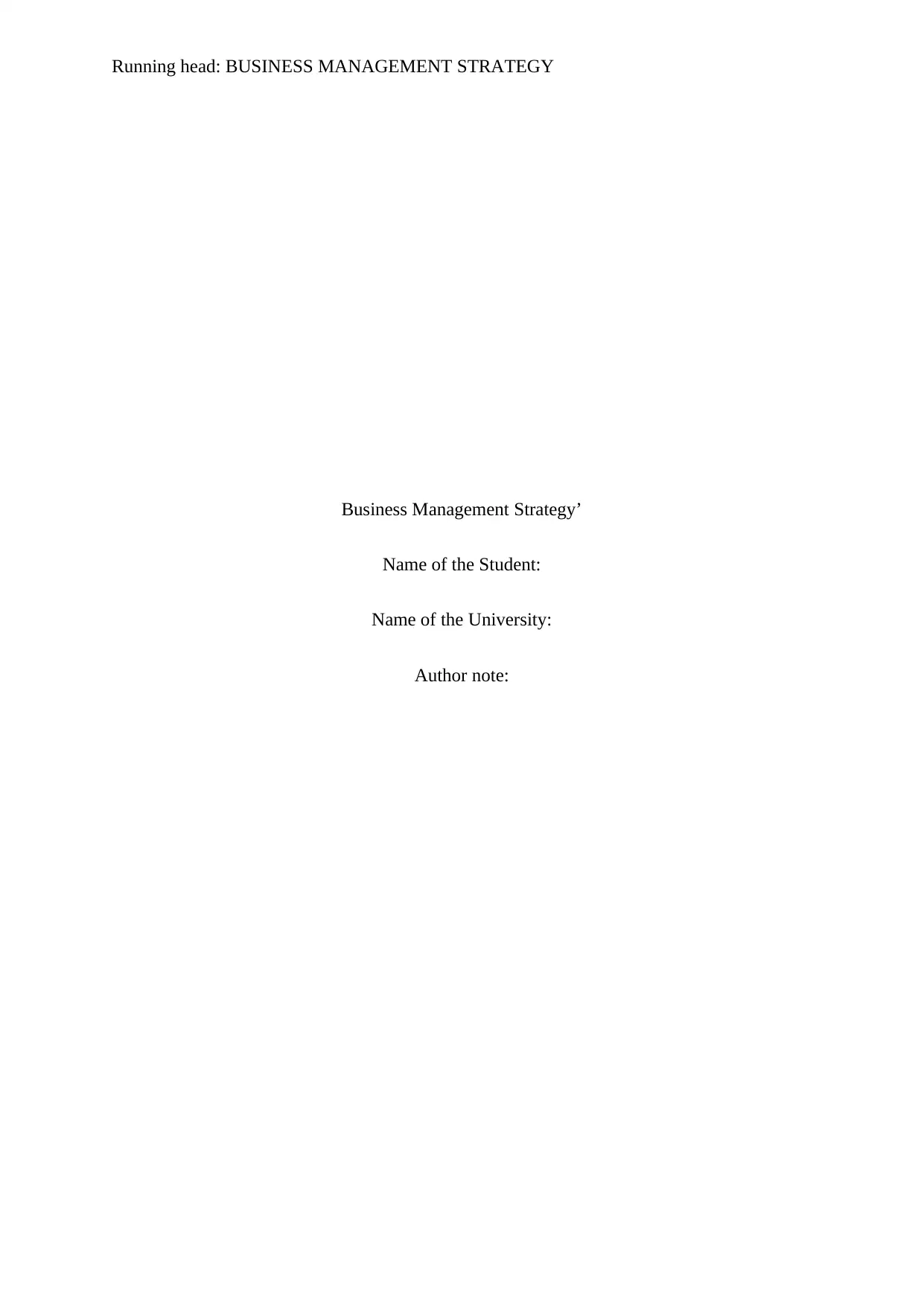
Running head: BUSINESS MANAGEMENT STRATEGY
Business Management Strategy’
Name of the Student:
Name of the University:
Author note:
Business Management Strategy’
Name of the Student:
Name of the University:
Author note:
Paraphrase This Document
Need a fresh take? Get an instant paraphrase of this document with our AI Paraphraser
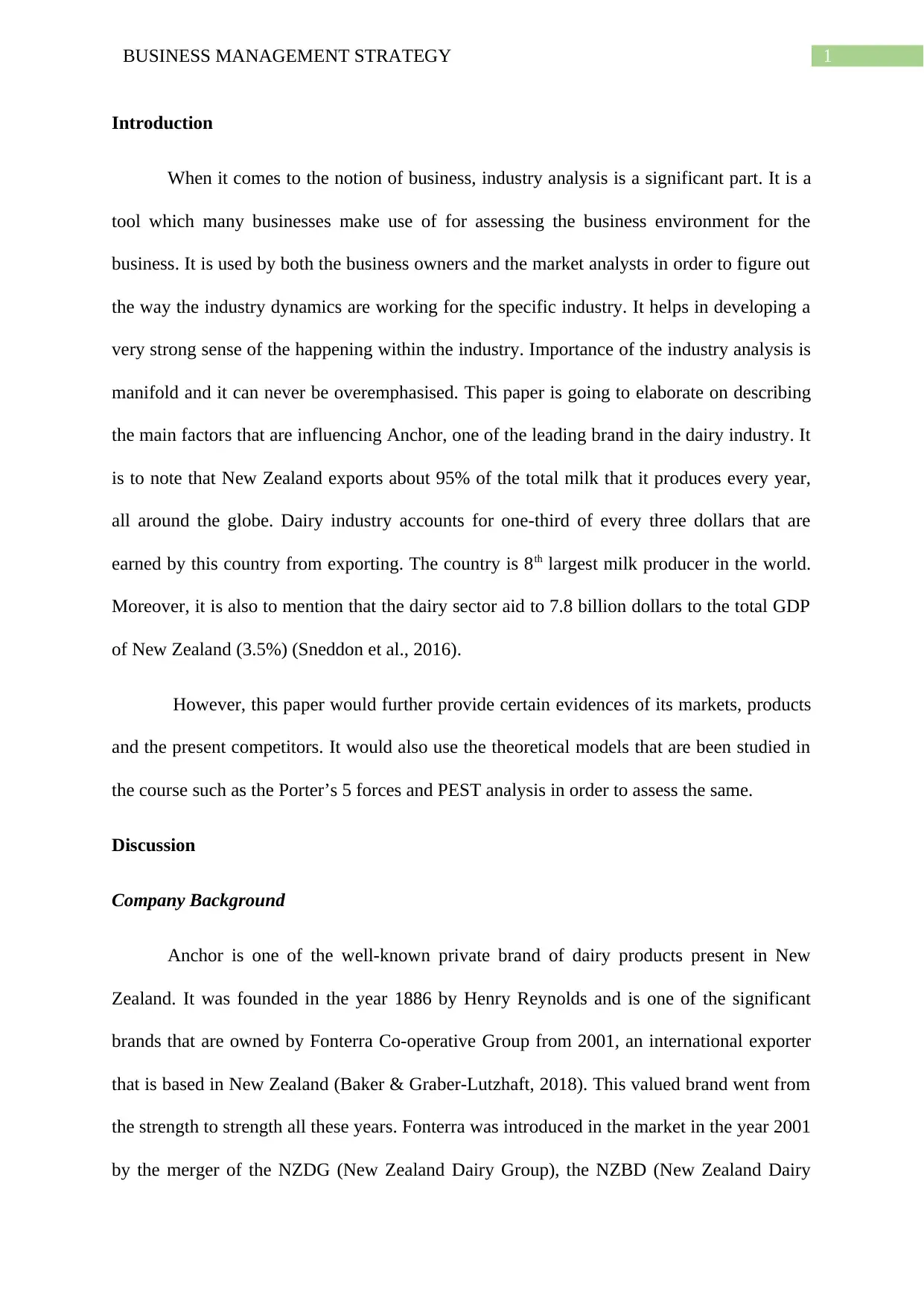
1BUSINESS MANAGEMENT STRATEGY
Introduction
When it comes to the notion of business, industry analysis is a significant part. It is a
tool which many businesses make use of for assessing the business environment for the
business. It is used by both the business owners and the market analysts in order to figure out
the way the industry dynamics are working for the specific industry. It helps in developing a
very strong sense of the happening within the industry. Importance of the industry analysis is
manifold and it can never be overemphasised. This paper is going to elaborate on describing
the main factors that are influencing Anchor, one of the leading brand in the dairy industry. It
is to note that New Zealand exports about 95% of the total milk that it produces every year,
all around the globe. Dairy industry accounts for one-third of every three dollars that are
earned by this country from exporting. The country is 8th largest milk producer in the world.
Moreover, it is also to mention that the dairy sector aid to 7.8 billion dollars to the total GDP
of New Zealand (3.5%) (Sneddon et al., 2016).
However, this paper would further provide certain evidences of its markets, products
and the present competitors. It would also use the theoretical models that are been studied in
the course such as the Porter’s 5 forces and PEST analysis in order to assess the same.
Discussion
Company Background
Anchor is one of the well-known private brand of dairy products present in New
Zealand. It was founded in the year 1886 by Henry Reynolds and is one of the significant
brands that are owned by Fonterra Co-operative Group from 2001, an international exporter
that is based in New Zealand (Baker & Graber-Lutzhaft, 2018). This valued brand went from
the strength to strength all these years. Fonterra was introduced in the market in the year 2001
by the merger of the NZDG (New Zealand Dairy Group), the NZBD (New Zealand Dairy
Introduction
When it comes to the notion of business, industry analysis is a significant part. It is a
tool which many businesses make use of for assessing the business environment for the
business. It is used by both the business owners and the market analysts in order to figure out
the way the industry dynamics are working for the specific industry. It helps in developing a
very strong sense of the happening within the industry. Importance of the industry analysis is
manifold and it can never be overemphasised. This paper is going to elaborate on describing
the main factors that are influencing Anchor, one of the leading brand in the dairy industry. It
is to note that New Zealand exports about 95% of the total milk that it produces every year,
all around the globe. Dairy industry accounts for one-third of every three dollars that are
earned by this country from exporting. The country is 8th largest milk producer in the world.
Moreover, it is also to mention that the dairy sector aid to 7.8 billion dollars to the total GDP
of New Zealand (3.5%) (Sneddon et al., 2016).
However, this paper would further provide certain evidences of its markets, products
and the present competitors. It would also use the theoretical models that are been studied in
the course such as the Porter’s 5 forces and PEST analysis in order to assess the same.
Discussion
Company Background
Anchor is one of the well-known private brand of dairy products present in New
Zealand. It was founded in the year 1886 by Henry Reynolds and is one of the significant
brands that are owned by Fonterra Co-operative Group from 2001, an international exporter
that is based in New Zealand (Baker & Graber-Lutzhaft, 2018). This valued brand went from
the strength to strength all these years. Fonterra was introduced in the market in the year 2001
by the merger of the NZDG (New Zealand Dairy Group), the NZBD (New Zealand Dairy
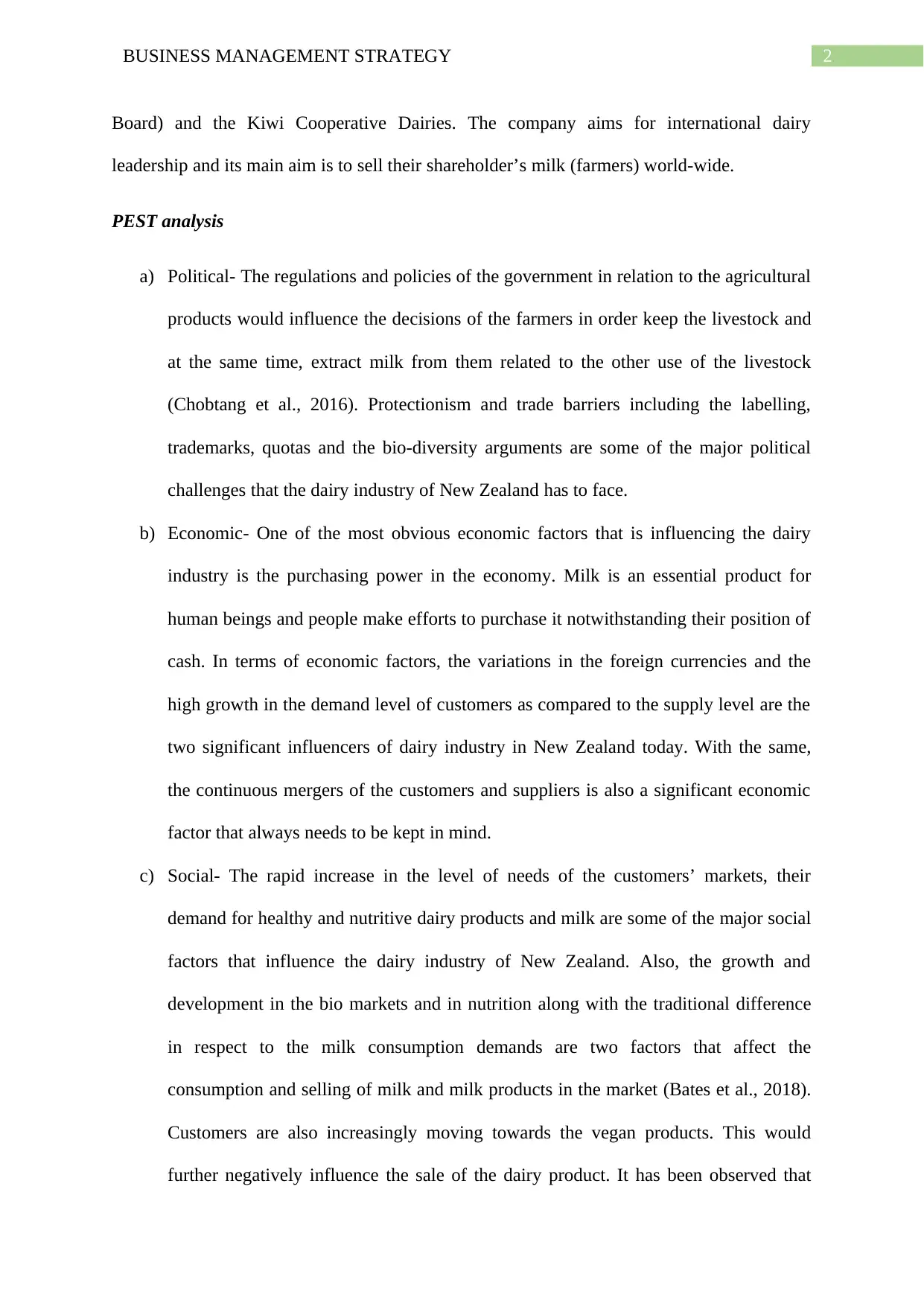
2BUSINESS MANAGEMENT STRATEGY
Board) and the Kiwi Cooperative Dairies. The company aims for international dairy
leadership and its main aim is to sell their shareholder’s milk (farmers) world-wide.
PEST analysis
a) Political- The regulations and policies of the government in relation to the agricultural
products would influence the decisions of the farmers in order keep the livestock and
at the same time, extract milk from them related to the other use of the livestock
(Chobtang et al., 2016). Protectionism and trade barriers including the labelling,
trademarks, quotas and the bio-diversity arguments are some of the major political
challenges that the dairy industry of New Zealand has to face.
b) Economic- One of the most obvious economic factors that is influencing the dairy
industry is the purchasing power in the economy. Milk is an essential product for
human beings and people make efforts to purchase it notwithstanding their position of
cash. In terms of economic factors, the variations in the foreign currencies and the
high growth in the demand level of customers as compared to the supply level are the
two significant influencers of dairy industry in New Zealand today. With the same,
the continuous mergers of the customers and suppliers is also a significant economic
factor that always needs to be kept in mind.
c) Social- The rapid increase in the level of needs of the customers’ markets, their
demand for healthy and nutritive dairy products and milk are some of the major social
factors that influence the dairy industry of New Zealand. Also, the growth and
development in the bio markets and in nutrition along with the traditional difference
in respect to the milk consumption demands are two factors that affect the
consumption and selling of milk and milk products in the market (Bates et al., 2018).
Customers are also increasingly moving towards the vegan products. This would
further negatively influence the sale of the dairy product. It has been observed that
Board) and the Kiwi Cooperative Dairies. The company aims for international dairy
leadership and its main aim is to sell their shareholder’s milk (farmers) world-wide.
PEST analysis
a) Political- The regulations and policies of the government in relation to the agricultural
products would influence the decisions of the farmers in order keep the livestock and
at the same time, extract milk from them related to the other use of the livestock
(Chobtang et al., 2016). Protectionism and trade barriers including the labelling,
trademarks, quotas and the bio-diversity arguments are some of the major political
challenges that the dairy industry of New Zealand has to face.
b) Economic- One of the most obvious economic factors that is influencing the dairy
industry is the purchasing power in the economy. Milk is an essential product for
human beings and people make efforts to purchase it notwithstanding their position of
cash. In terms of economic factors, the variations in the foreign currencies and the
high growth in the demand level of customers as compared to the supply level are the
two significant influencers of dairy industry in New Zealand today. With the same,
the continuous mergers of the customers and suppliers is also a significant economic
factor that always needs to be kept in mind.
c) Social- The rapid increase in the level of needs of the customers’ markets, their
demand for healthy and nutritive dairy products and milk are some of the major social
factors that influence the dairy industry of New Zealand. Also, the growth and
development in the bio markets and in nutrition along with the traditional difference
in respect to the milk consumption demands are two factors that affect the
consumption and selling of milk and milk products in the market (Bates et al., 2018).
Customers are also increasingly moving towards the vegan products. This would
further negatively influence the sale of the dairy product. It has been observed that
⊘ This is a preview!⊘
Do you want full access?
Subscribe today to unlock all pages.

Trusted by 1+ million students worldwide
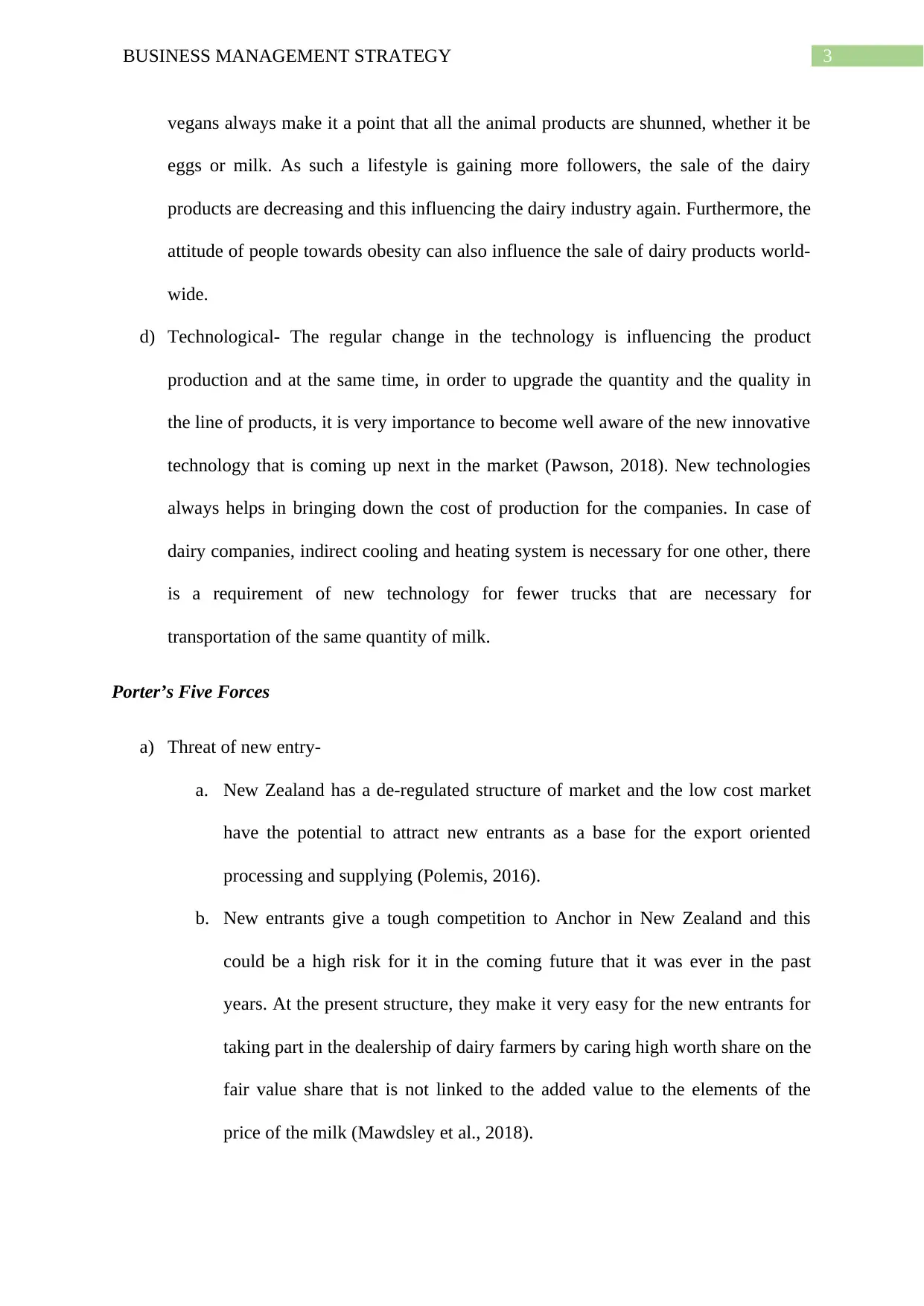
3BUSINESS MANAGEMENT STRATEGY
vegans always make it a point that all the animal products are shunned, whether it be
eggs or milk. As such a lifestyle is gaining more followers, the sale of the dairy
products are decreasing and this influencing the dairy industry again. Furthermore, the
attitude of people towards obesity can also influence the sale of dairy products world-
wide.
d) Technological- The regular change in the technology is influencing the product
production and at the same time, in order to upgrade the quantity and the quality in
the line of products, it is very importance to become well aware of the new innovative
technology that is coming up next in the market (Pawson, 2018). New technologies
always helps in bringing down the cost of production for the companies. In case of
dairy companies, indirect cooling and heating system is necessary for one other, there
is a requirement of new technology for fewer trucks that are necessary for
transportation of the same quantity of milk.
Porter’s Five Forces
a) Threat of new entry-
a. New Zealand has a de-regulated structure of market and the low cost market
have the potential to attract new entrants as a base for the export oriented
processing and supplying (Polemis, 2016).
b. New entrants give a tough competition to Anchor in New Zealand and this
could be a high risk for it in the coming future that it was ever in the past
years. At the present structure, they make it very easy for the new entrants for
taking part in the dealership of dairy farmers by caring high worth share on the
fair value share that is not linked to the added value to the elements of the
price of the milk (Mawdsley et al., 2018).
vegans always make it a point that all the animal products are shunned, whether it be
eggs or milk. As such a lifestyle is gaining more followers, the sale of the dairy
products are decreasing and this influencing the dairy industry again. Furthermore, the
attitude of people towards obesity can also influence the sale of dairy products world-
wide.
d) Technological- The regular change in the technology is influencing the product
production and at the same time, in order to upgrade the quantity and the quality in
the line of products, it is very importance to become well aware of the new innovative
technology that is coming up next in the market (Pawson, 2018). New technologies
always helps in bringing down the cost of production for the companies. In case of
dairy companies, indirect cooling and heating system is necessary for one other, there
is a requirement of new technology for fewer trucks that are necessary for
transportation of the same quantity of milk.
Porter’s Five Forces
a) Threat of new entry-
a. New Zealand has a de-regulated structure of market and the low cost market
have the potential to attract new entrants as a base for the export oriented
processing and supplying (Polemis, 2016).
b. New entrants give a tough competition to Anchor in New Zealand and this
could be a high risk for it in the coming future that it was ever in the past
years. At the present structure, they make it very easy for the new entrants for
taking part in the dealership of dairy farmers by caring high worth share on the
fair value share that is not linked to the added value to the elements of the
price of the milk (Mawdsley et al., 2018).
Paraphrase This Document
Need a fresh take? Get an instant paraphrase of this document with our AI Paraphraser
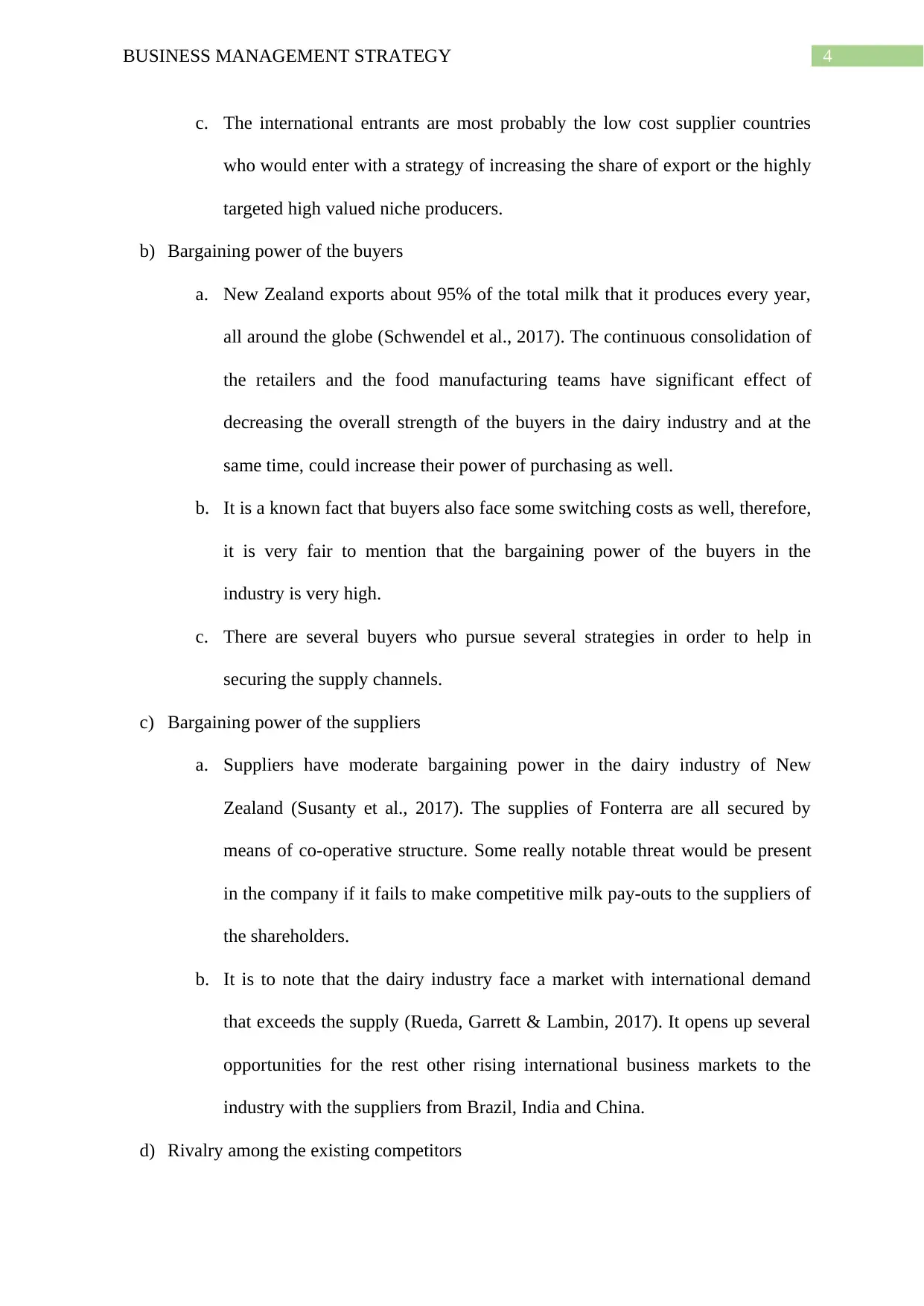
4BUSINESS MANAGEMENT STRATEGY
c. The international entrants are most probably the low cost supplier countries
who would enter with a strategy of increasing the share of export or the highly
targeted high valued niche producers.
b) Bargaining power of the buyers
a. New Zealand exports about 95% of the total milk that it produces every year,
all around the globe (Schwendel et al., 2017). The continuous consolidation of
the retailers and the food manufacturing teams have significant effect of
decreasing the overall strength of the buyers in the dairy industry and at the
same time, could increase their power of purchasing as well.
b. It is a known fact that buyers also face some switching costs as well, therefore,
it is very fair to mention that the bargaining power of the buyers in the
industry is very high.
c. There are several buyers who pursue several strategies in order to help in
securing the supply channels.
c) Bargaining power of the suppliers
a. Suppliers have moderate bargaining power in the dairy industry of New
Zealand (Susanty et al., 2017). The supplies of Fonterra are all secured by
means of co-operative structure. Some really notable threat would be present
in the company if it fails to make competitive milk pay-outs to the suppliers of
the shareholders.
b. It is to note that the dairy industry face a market with international demand
that exceeds the supply (Rueda, Garrett & Lambin, 2017). It opens up several
opportunities for the rest other rising international business markets to the
industry with the suppliers from Brazil, India and China.
d) Rivalry among the existing competitors
c. The international entrants are most probably the low cost supplier countries
who would enter with a strategy of increasing the share of export or the highly
targeted high valued niche producers.
b) Bargaining power of the buyers
a. New Zealand exports about 95% of the total milk that it produces every year,
all around the globe (Schwendel et al., 2017). The continuous consolidation of
the retailers and the food manufacturing teams have significant effect of
decreasing the overall strength of the buyers in the dairy industry and at the
same time, could increase their power of purchasing as well.
b. It is a known fact that buyers also face some switching costs as well, therefore,
it is very fair to mention that the bargaining power of the buyers in the
industry is very high.
c. There are several buyers who pursue several strategies in order to help in
securing the supply channels.
c) Bargaining power of the suppliers
a. Suppliers have moderate bargaining power in the dairy industry of New
Zealand (Susanty et al., 2017). The supplies of Fonterra are all secured by
means of co-operative structure. Some really notable threat would be present
in the company if it fails to make competitive milk pay-outs to the suppliers of
the shareholders.
b. It is to note that the dairy industry face a market with international demand
that exceeds the supply (Rueda, Garrett & Lambin, 2017). It opens up several
opportunities for the rest other rising international business markets to the
industry with the suppliers from Brazil, India and China.
d) Rivalry among the existing competitors
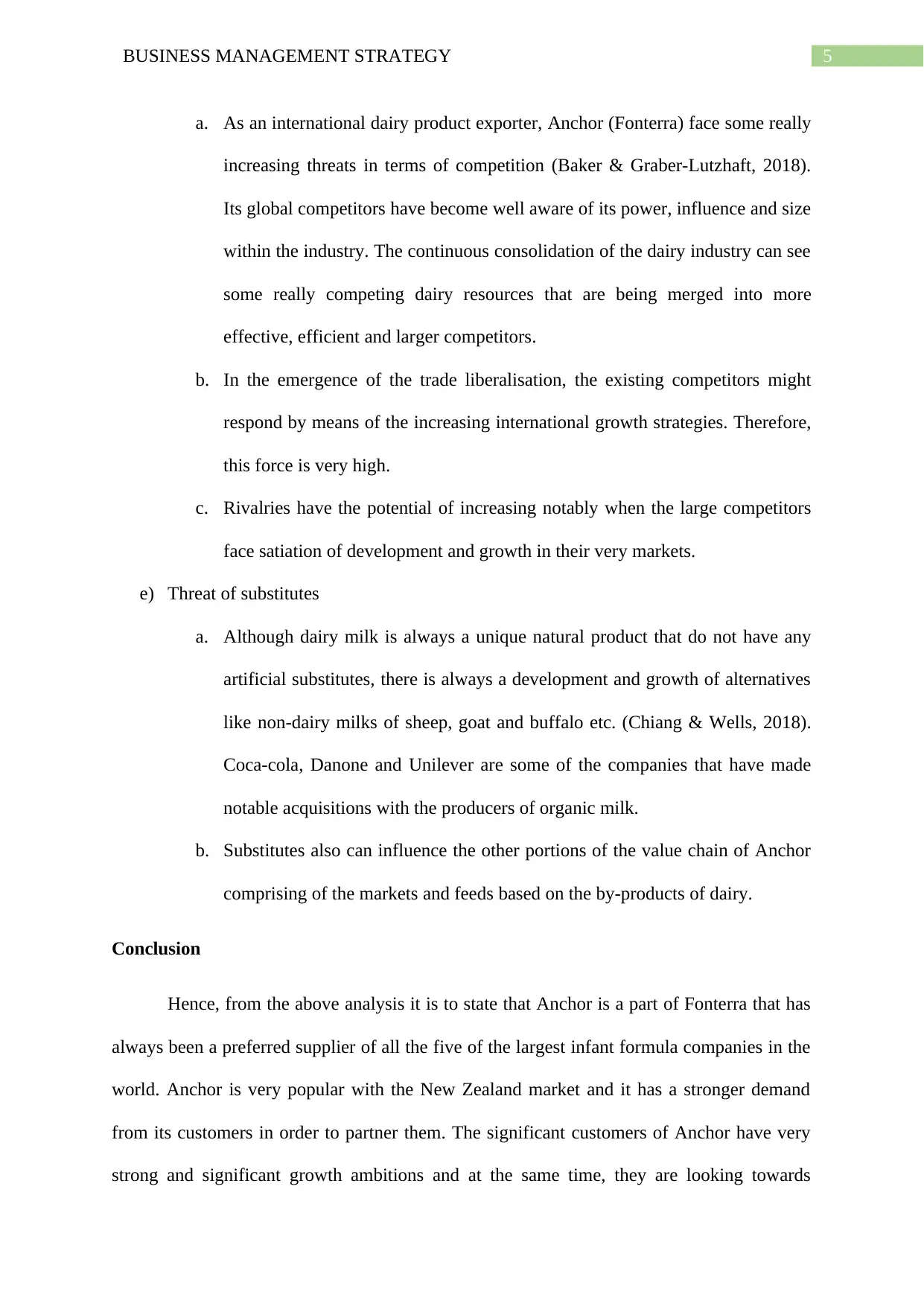
5BUSINESS MANAGEMENT STRATEGY
a. As an international dairy product exporter, Anchor (Fonterra) face some really
increasing threats in terms of competition (Baker & Graber-Lutzhaft, 2018).
Its global competitors have become well aware of its power, influence and size
within the industry. The continuous consolidation of the dairy industry can see
some really competing dairy resources that are being merged into more
effective, efficient and larger competitors.
b. In the emergence of the trade liberalisation, the existing competitors might
respond by means of the increasing international growth strategies. Therefore,
this force is very high.
c. Rivalries have the potential of increasing notably when the large competitors
face satiation of development and growth in their very markets.
e) Threat of substitutes
a. Although dairy milk is always a unique natural product that do not have any
artificial substitutes, there is always a development and growth of alternatives
like non-dairy milks of sheep, goat and buffalo etc. (Chiang & Wells, 2018).
Coca-cola, Danone and Unilever are some of the companies that have made
notable acquisitions with the producers of organic milk.
b. Substitutes also can influence the other portions of the value chain of Anchor
comprising of the markets and feeds based on the by-products of dairy.
Conclusion
Hence, from the above analysis it is to state that Anchor is a part of Fonterra that has
always been a preferred supplier of all the five of the largest infant formula companies in the
world. Anchor is very popular with the New Zealand market and it has a stronger demand
from its customers in order to partner them. The significant customers of Anchor have very
strong and significant growth ambitions and at the same time, they are looking towards
a. As an international dairy product exporter, Anchor (Fonterra) face some really
increasing threats in terms of competition (Baker & Graber-Lutzhaft, 2018).
Its global competitors have become well aware of its power, influence and size
within the industry. The continuous consolidation of the dairy industry can see
some really competing dairy resources that are being merged into more
effective, efficient and larger competitors.
b. In the emergence of the trade liberalisation, the existing competitors might
respond by means of the increasing international growth strategies. Therefore,
this force is very high.
c. Rivalries have the potential of increasing notably when the large competitors
face satiation of development and growth in their very markets.
e) Threat of substitutes
a. Although dairy milk is always a unique natural product that do not have any
artificial substitutes, there is always a development and growth of alternatives
like non-dairy milks of sheep, goat and buffalo etc. (Chiang & Wells, 2018).
Coca-cola, Danone and Unilever are some of the companies that have made
notable acquisitions with the producers of organic milk.
b. Substitutes also can influence the other portions of the value chain of Anchor
comprising of the markets and feeds based on the by-products of dairy.
Conclusion
Hence, from the above analysis it is to state that Anchor is a part of Fonterra that has
always been a preferred supplier of all the five of the largest infant formula companies in the
world. Anchor is very popular with the New Zealand market and it has a stronger demand
from its customers in order to partner them. The significant customers of Anchor have very
strong and significant growth ambitions and at the same time, they are looking towards
⊘ This is a preview!⊘
Do you want full access?
Subscribe today to unlock all pages.

Trusted by 1+ million students worldwide
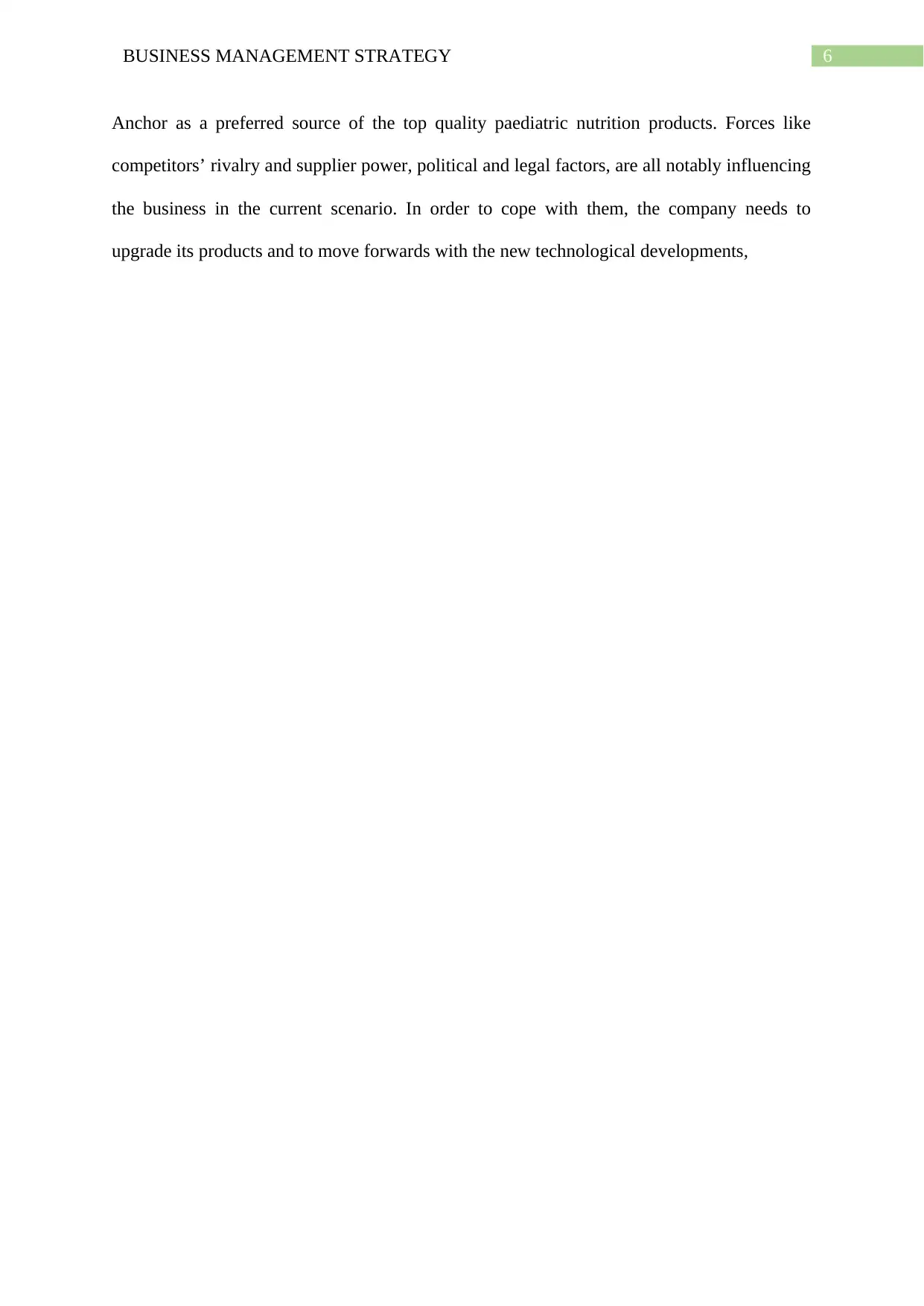
6BUSINESS MANAGEMENT STRATEGY
Anchor as a preferred source of the top quality paediatric nutrition products. Forces like
competitors’ rivalry and supplier power, political and legal factors, are all notably influencing
the business in the current scenario. In order to cope with them, the company needs to
upgrade its products and to move forwards with the new technological developments,
Anchor as a preferred source of the top quality paediatric nutrition products. Forces like
competitors’ rivalry and supplier power, political and legal factors, are all notably influencing
the business in the current scenario. In order to cope with them, the company needs to
upgrade its products and to move forwards with the new technological developments,
Paraphrase This Document
Need a fresh take? Get an instant paraphrase of this document with our AI Paraphraser
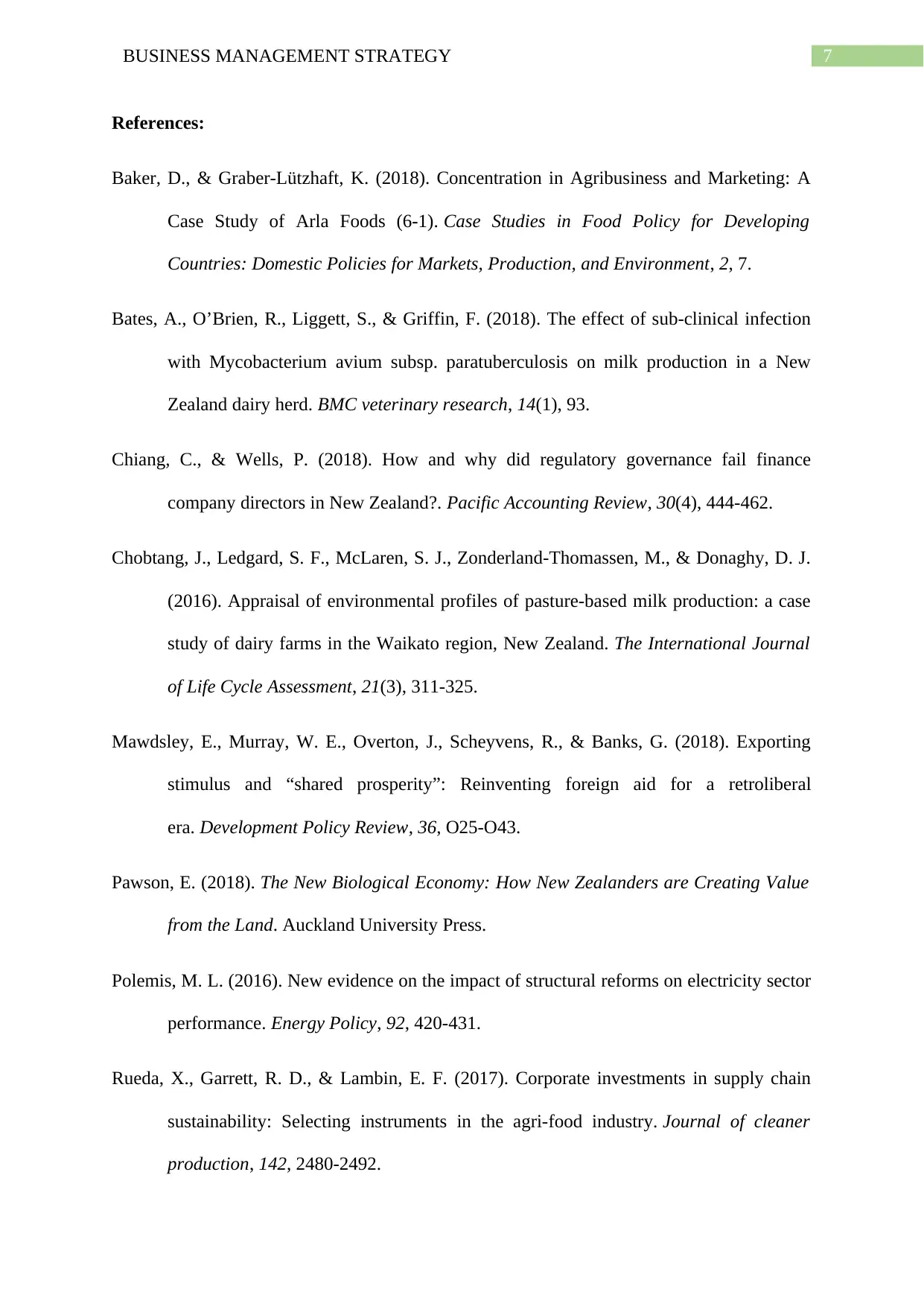
7BUSINESS MANAGEMENT STRATEGY
References:
Baker, D., & Graber-Lützhaft, K. (2018). Concentration in Agribusiness and Marketing: A
Case Study of Arla Foods (6-1). Case Studies in Food Policy for Developing
Countries: Domestic Policies for Markets, Production, and Environment, 2, 7.
Bates, A., O’Brien, R., Liggett, S., & Griffin, F. (2018). The effect of sub-clinical infection
with Mycobacterium avium subsp. paratuberculosis on milk production in a New
Zealand dairy herd. BMC veterinary research, 14(1), 93.
Chiang, C., & Wells, P. (2018). How and why did regulatory governance fail finance
company directors in New Zealand?. Pacific Accounting Review, 30(4), 444-462.
Chobtang, J., Ledgard, S. F., McLaren, S. J., Zonderland-Thomassen, M., & Donaghy, D. J.
(2016). Appraisal of environmental profiles of pasture-based milk production: a case
study of dairy farms in the Waikato region, New Zealand. The International Journal
of Life Cycle Assessment, 21(3), 311-325.
Mawdsley, E., Murray, W. E., Overton, J., Scheyvens, R., & Banks, G. (2018). Exporting
stimulus and “shared prosperity”: Reinventing foreign aid for a retroliberal
era. Development Policy Review, 36, O25-O43.
Pawson, E. (2018). The New Biological Economy: How New Zealanders are Creating Value
from the Land. Auckland University Press.
Polemis, M. L. (2016). New evidence on the impact of structural reforms on electricity sector
performance. Energy Policy, 92, 420-431.
Rueda, X., Garrett, R. D., & Lambin, E. F. (2017). Corporate investments in supply chain
sustainability: Selecting instruments in the agri-food industry. Journal of cleaner
production, 142, 2480-2492.
References:
Baker, D., & Graber-Lützhaft, K. (2018). Concentration in Agribusiness and Marketing: A
Case Study of Arla Foods (6-1). Case Studies in Food Policy for Developing
Countries: Domestic Policies for Markets, Production, and Environment, 2, 7.
Bates, A., O’Brien, R., Liggett, S., & Griffin, F. (2018). The effect of sub-clinical infection
with Mycobacterium avium subsp. paratuberculosis on milk production in a New
Zealand dairy herd. BMC veterinary research, 14(1), 93.
Chiang, C., & Wells, P. (2018). How and why did regulatory governance fail finance
company directors in New Zealand?. Pacific Accounting Review, 30(4), 444-462.
Chobtang, J., Ledgard, S. F., McLaren, S. J., Zonderland-Thomassen, M., & Donaghy, D. J.
(2016). Appraisal of environmental profiles of pasture-based milk production: a case
study of dairy farms in the Waikato region, New Zealand. The International Journal
of Life Cycle Assessment, 21(3), 311-325.
Mawdsley, E., Murray, W. E., Overton, J., Scheyvens, R., & Banks, G. (2018). Exporting
stimulus and “shared prosperity”: Reinventing foreign aid for a retroliberal
era. Development Policy Review, 36, O25-O43.
Pawson, E. (2018). The New Biological Economy: How New Zealanders are Creating Value
from the Land. Auckland University Press.
Polemis, M. L. (2016). New evidence on the impact of structural reforms on electricity sector
performance. Energy Policy, 92, 420-431.
Rueda, X., Garrett, R. D., & Lambin, E. F. (2017). Corporate investments in supply chain
sustainability: Selecting instruments in the agri-food industry. Journal of cleaner
production, 142, 2480-2492.
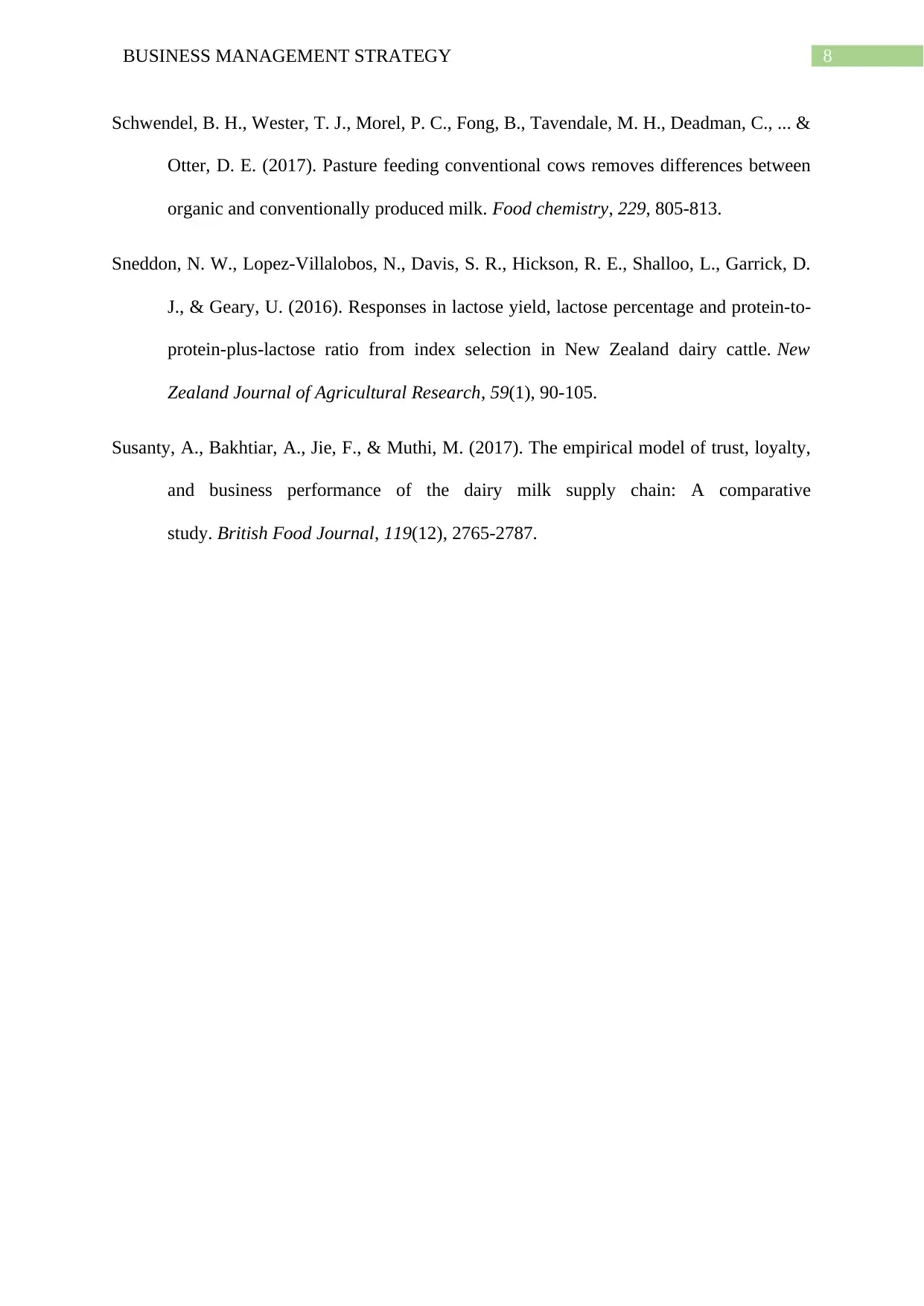
8BUSINESS MANAGEMENT STRATEGY
Schwendel, B. H., Wester, T. J., Morel, P. C., Fong, B., Tavendale, M. H., Deadman, C., ... &
Otter, D. E. (2017). Pasture feeding conventional cows removes differences between
organic and conventionally produced milk. Food chemistry, 229, 805-813.
Sneddon, N. W., Lopez-Villalobos, N., Davis, S. R., Hickson, R. E., Shalloo, L., Garrick, D.
J., & Geary, U. (2016). Responses in lactose yield, lactose percentage and protein-to-
protein-plus-lactose ratio from index selection in New Zealand dairy cattle. New
Zealand Journal of Agricultural Research, 59(1), 90-105.
Susanty, A., Bakhtiar, A., Jie, F., & Muthi, M. (2017). The empirical model of trust, loyalty,
and business performance of the dairy milk supply chain: A comparative
study. British Food Journal, 119(12), 2765-2787.
Schwendel, B. H., Wester, T. J., Morel, P. C., Fong, B., Tavendale, M. H., Deadman, C., ... &
Otter, D. E. (2017). Pasture feeding conventional cows removes differences between
organic and conventionally produced milk. Food chemistry, 229, 805-813.
Sneddon, N. W., Lopez-Villalobos, N., Davis, S. R., Hickson, R. E., Shalloo, L., Garrick, D.
J., & Geary, U. (2016). Responses in lactose yield, lactose percentage and protein-to-
protein-plus-lactose ratio from index selection in New Zealand dairy cattle. New
Zealand Journal of Agricultural Research, 59(1), 90-105.
Susanty, A., Bakhtiar, A., Jie, F., & Muthi, M. (2017). The empirical model of trust, loyalty,
and business performance of the dairy milk supply chain: A comparative
study. British Food Journal, 119(12), 2765-2787.
⊘ This is a preview!⊘
Do you want full access?
Subscribe today to unlock all pages.

Trusted by 1+ million students worldwide
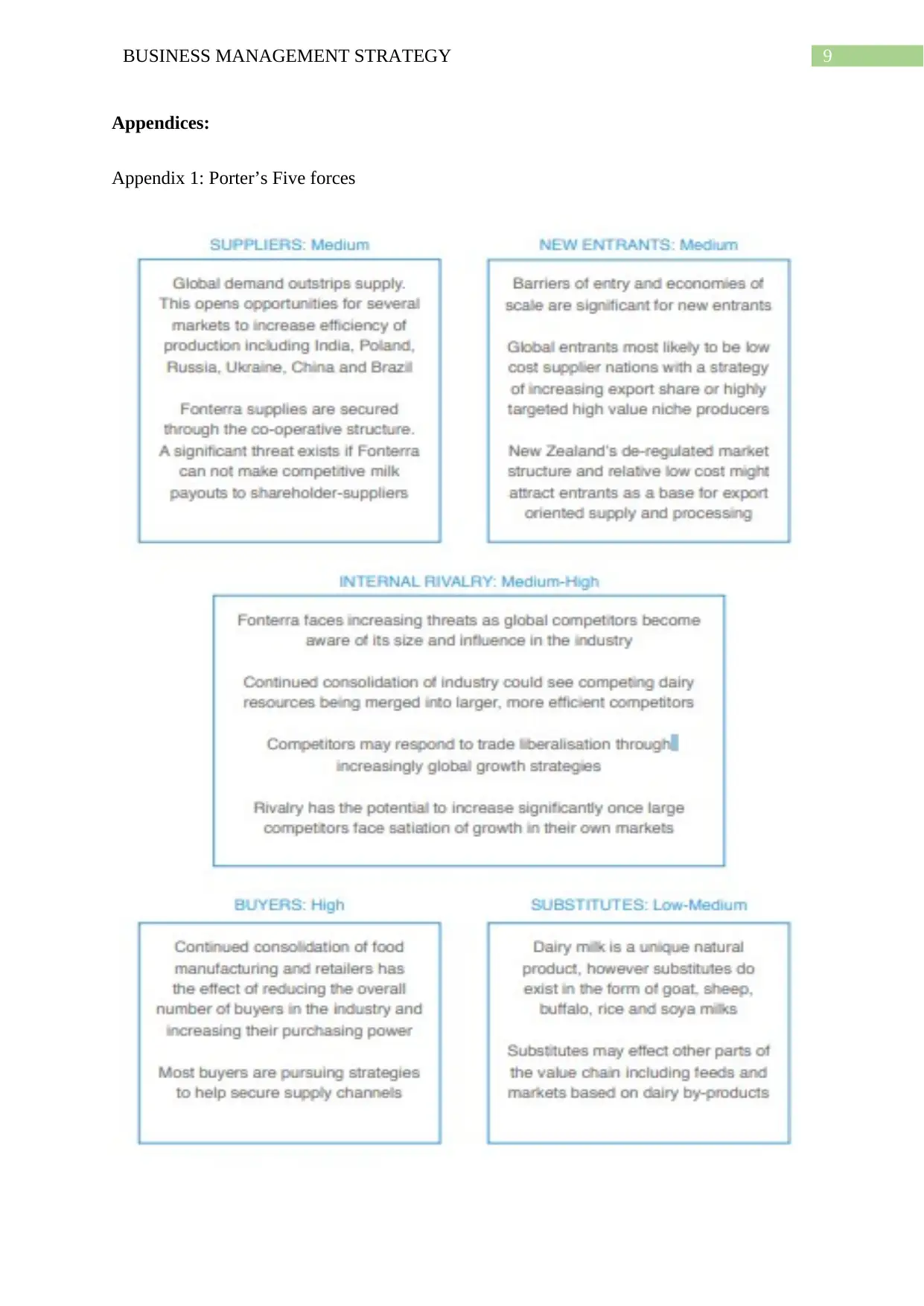
9BUSINESS MANAGEMENT STRATEGY
Appendices:
Appendix 1: Porter’s Five forces
Appendices:
Appendix 1: Porter’s Five forces
Paraphrase This Document
Need a fresh take? Get an instant paraphrase of this document with our AI Paraphraser
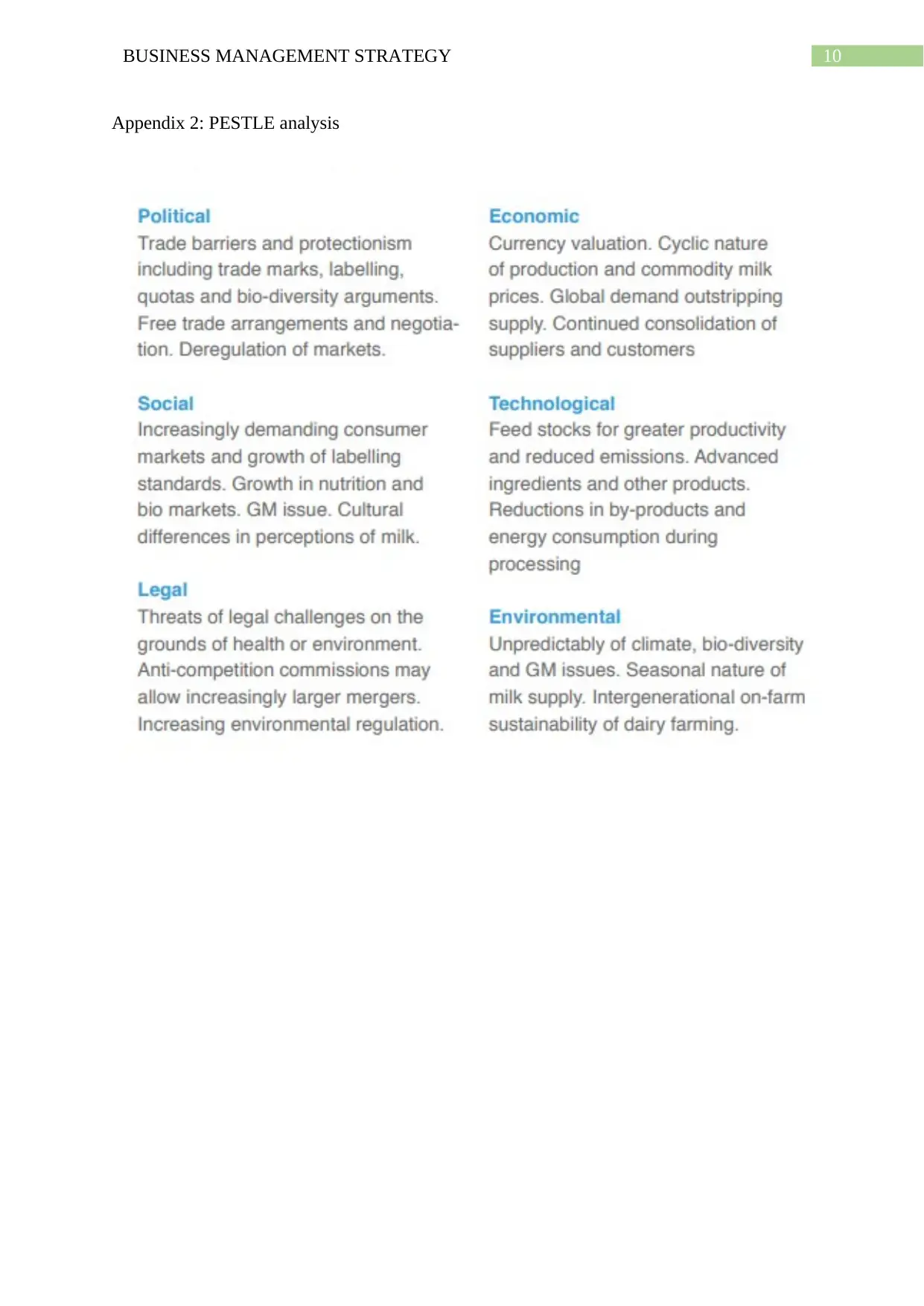
10BUSINESS MANAGEMENT STRATEGY
Appendix 2: PESTLE analysis
Appendix 2: PESTLE analysis
1 out of 11
Related Documents
Your All-in-One AI-Powered Toolkit for Academic Success.
+13062052269
info@desklib.com
Available 24*7 on WhatsApp / Email
![[object Object]](/_next/static/media/star-bottom.7253800d.svg)
Unlock your academic potential
Copyright © 2020–2025 A2Z Services. All Rights Reserved. Developed and managed by ZUCOL.





